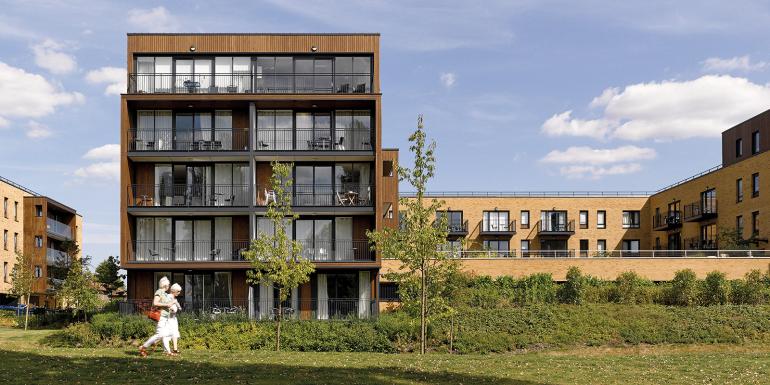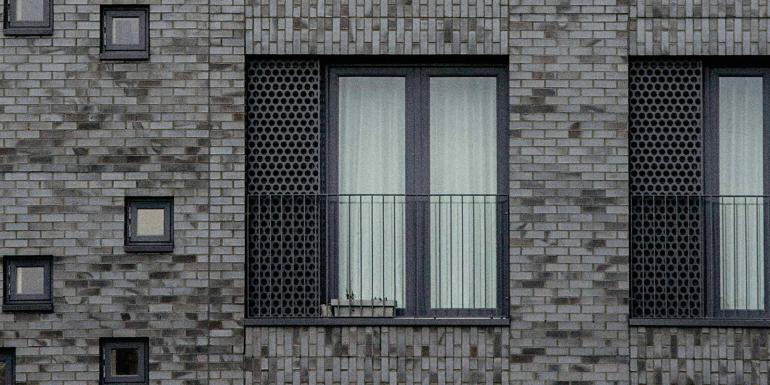Open and shut case

In the race to make new builds and existing buildings energy and heat efficient, acoustic, ventilation and thermal comfort practicalities may have been overlooked. As Elaine Knutt discovers, that’s about to change.
It’s a conundrum playing out across the country: well-insulated, air-tight residential blocks are designed with ventilation strategies that rely on opening the windows to purge heat, when the statutory acoustic assessment for its noisy, urban site stipulated that the windows should be closed. Residents are given the keys to flats built on incompatible assumptions, with a foundation of contradictory reports that were never cross-referenced – or perhaps simply ignored.
It results in complex trade-offs in comfort levels where opening the window to create a livable temperature leads to a non-stop soundtrack of traffic and urban noise that impacts sleep and mental wellbeing. Alternatively, closing the windows – and relying on ventilation systems that are often inadequate, or noisy, or both – runs the risk of uncomfortable temperatures, stuffiness and high carbon monoxide levels. If the flat is on the ground or first floor, or accessible from the street, then security has to be added to the equation.
The situation has arisen because a trio of interlinked issues – acoustics, ventilation and overheating – are regulated by a triad of disconnected authorities. To gain planning permission, developers must submit an acoustic assessment demonstrating that dwellings will not have excessive internal noise levels, but this can be based on the assumption the windows are shut. Meanwhile, the ventilation axis is owned by building control, and there is no statutory requirement to do an overheating assessment to predict thermal comfort.
“The acoustic report is assessed by the planners, who delegate it to the environmental health team, the ventilation strategy may not be determined at planning stage and is regulated by building control, and thermal comfort may be considered by different consultants. No one is joining the dots, so no one’s joining them together,” says Jack Harvie-Clark, immediate Past-Chair of the Association of Noise Consultants (ANC) and Director of Apex Acoustics.
To help resolve the conundrum, the ANC has produced new guidance to promote a balance between acoustic comfort and thermal comfort, and to give the different technical specialisms a common language and metrics. If a decade’s worth of residential development has been built with problems, the ANC hopes that better conversations – guided by fixed, quantitative values on noise and ventilation levels – can ensure that the next decade offers a more intelligent response.

Trinity of factors
Dan Saunders, Director at acoustic consultants Clarke Saunders, and Chair of the ANC, says: “The Acoustics, Ventilation and Overheating [AVO] Guide gives a holistic view of internal acoustic conditions and thermal comfort. It gives environmental health officers [EHOs] a reference to ask applicants or developers, ‘Has this proposal taken account of this guidance?’ and ‘What are the expectations on indoor air quality, or indoor acoustic comfort?’. And it should also help to educate people in the design team to realise that we need the acoustics advice early, not once the layout has been frozen.”
The guide was launched in January, with only a few weeks to gain traction before the Covid-19 pandemic froze projects in their tracks. Jo Miller, Director of independent acoustic and air quality consultancy Miller Goodall, says that the guidance is already proving useful. “We have directed ventilation engineers [to the guidance] to give them a better understanding of the issues between noise, ventilation and overheating. For local authority environmental health and planning departments, it will help them understand how the three areas interlink.”
Dr Anthony Chilton, Chair of the ANC working group that produced the guide, and a Head of Acoustics at building services consultant Max Fordham, agrees: “People are already being paid to do assessments using the guide, to see, for instance, if you can reduce the need for mechanical cooling. Whether it has changed the design of a building yet is harder to assess.”
The guide covers new-build residential projects, where sustainability and practicality tend to favour sites next to noise-producing rail lines and traffic arteries. For reasons of cost, the problem mainly manifests in social housing, or the affordable element of mixed tenure schemes, although consultants also describe problems in student accommodation and care homes. However, the guide doesn’t cover retrofit programmes, which has seen plenty of problematic examples of improving insulation and airtightness at the expense of reduced ventilation and greater noise risk.
But the number of homes likely to find themselves at the centre of the Venn diagram of overlapping vulnerabilities is only likely to increase, as energy efficiency regulation tightens insulation standards and airtightness. “More and more we are seeing that overheating is an issue. Buildings have more insulation for good levels of energy efficiency, and we’re having hotter summers,” says Carolina Caneva, a sustainability specialist and Associate in the Development Consultancy Team at PRP Architects. “At the same time, a lot of clients want to be climate proof.”
Arrested development
Failure to balance acoustic and other environmental requirements effectively starts with disconnects in the development process. When a proposal is submitted for planning approval, acoustic assessments estimating internal noise levels must be submitted to the planners, with an EHO making a recommendation to the planning team who in turn make a recommendation to the committee. A project may be granted permission with conditions attached on mitigating internal noise, but these are never backed by post-completion acoustic checks, leaving an unclosed loop large enough to drive a deficient design through.
Meanwhile, that process is entirely separate from the ventilation strategy approvals needed to achieve compliance with Approved Document F, which is assessed by the building control team. The result is a situation where incompatible solutions can be developed. And while it’s easy to imagine that qualified and experienced services consultants are responsible for the ventilation design, Harvie-Clark says that, in the real world, it is common that no one takes responsibility for the ventilation design. Decisions on the size and placement of vents or the power of fans are often delegated to the subcontractor, working to a few notes on drawing that they should “comply with Building Regulations”.
As a result, compliance with Approved Document F is patchy at best, non-existent at worst. Harvie-Clark summarises the results of a government study by consultancy Aecom, published last September. “The government did research on whether the Part F of Building Regulations gives you good air quality. But they found so few homes that actually comply with the Regulations, they can’t tell if the provisions are effective! Almost none complied because there were not enough trickle vents, or the air flow through fans didn’t meet the minimum requirements.” The result can be fewer air changes than targeted in the design, with Harvie-Clark quoting research that suggests health can be impacted from poor indoor air quality, particularly when the air tightness is less than 3-5m3/m2/hour.
Finally, overheating assessments are not a statutory requirement in the planning system except in London, where CIBSE Technical Memorandum 59 has been adopted into the London Plan. Thermal models calculate the risk of overheating, in terms of annualised hours that exceed maximum and minimum temperatures, by inputting data on materials, U-values, air-tightness and solar gain. However, the input data will look very different if the acoustic strategy recommendations on the acceptability of opening the windows are factored in.
Apex Acoustics has undertaken its own research into the issue, Harvie-Clark explains. “We went through 160 planning applications for major developments in London and found that of those that had both noise and overheating assessments, 85% assumed that the windows were open for the overheating assessment and closed in the noise assessment – even where the two assessments were done by the same company. “You could say the industry standard has been to make incompatible assumptions. But in fairness, there was previously no guidance on how to assess noise conditions where you are relying on opening windows to deal with overheating.”
Process and inertia
At Max Fordham, Chilton agrees that the problem may not be lack of awareness, but awareness failing to trigger action. The consultancy was hired to undertake a post-occupancy review of a large, 1,000-dwelling, social housing development in London built five years ago on a busy road. The review was prompted by resident complaints of overheating, although Chilton says it was just as much an acoustic problem – and one that had been accurately foreseen.
“We managed to get hold of the original acoustician’s report, which said that internal noise levels would be high when windows are open,” he says. “It wasn’t that people weren’t aware. Either there was confusion, with overheating and acoustics regarded as separate issues: you can’t assume that two teams will talk to one another, or that one will pick up statements in the other’s reports. Alternatively, the problem was recognised, but it would have cost money to resolve and so nothing happened.”
Chilton notes that the lack of a regulatory requirement to assess noise levels for the overheating situation leaves cost-conscious developers an open invitation. “Measures to improve summertime noise levels are often discounted on the basis of cost because they are not mandatory.”
However, Harvie-Clark believes that, with growing awareness of the problem, commercial pressures are starting to apply, as owners and developers realise that buildings harmful to health can harm their own commercial health. “People are being sued for delivering buildings that aren’t fit to live in; there is legal action going on, although everyone wants to settle cases out of court. Litigation is happening and developers are increasingly concerned about overheating risks.”
But James Butcher, Head of Policy and Research at the National Federation of Builders, says that neither voluntary guidance nor commercial pressure alone will be enough to drive change, particularly in the social housing sector. “We’ve had too much consideration of energy efficiency, without equal consideration of other factors that affect wellbeing, such as ventilation and noise levels. If you’re relying on purge ventilation but the windows open onto a busy highway, that hasn’t really been thought about. We now have a decade’s worth of work that has caused unintended consequences. We need a long-term renovation strategy as part of the industry’s post-Covid-19 recovery plan.”
He adds: “One of the key issues with all forms of guidance is that the people who are already interested in quality and achieving high standards are likely to see it, whereas most of the problems are created by the people working to minimum standards or a low level of quality. We need a more widespread approach – the guide is probably unlikely to change things on its own.
Chilton agrees that voluntary guidance may not be enough to shift entrenched approaches cemented by financial disincentives. “Certain things have to be driven by regulation, for instance thermal insulation. In the absence of clear Building Regulations requirements, developers would be unlikely to achieve the current thermal insulation standards given the long pay-back period. This issue is the same – there is no market incentive, so it will require a regulatory push to move the industry towards providing better environmental conditions for occupants.”

Regulations vs guidance
Local authorities used to apply centralised planning policy on noise levels contained in the government’s Planning Policy Guidance (PPG) Notes 24, but PPGs were abolished as part of the reforms that created the and National Planning Policy Framework in 2012. This move coincided with a decade of austerity measures that saw environmental health and planning teams shrink to skeleton operations without breadth or depth of experience.
In response to the removal of PPG 24, the Institute of Acoustics and Chartered Institute of Environmental Health collaborated on developing guidance to advise local authorities and practitioners on how to chart a course through the subject’s technical and legal issues, bearing in mind that EHOs also have to consider a cross section of issues across housing, public health and safety and food safety. “People in acoustics said, ‘if there is no government guidance, we’ll write it ourselves’,” recalls Harvie-Clarke.
Saunders explains that Professional Practice Guidance (ProPG) Planning & Noise – New Residential Development (May 2017) draws on PPG 24 in classifying sites into risk categories according to the impact of predicted noise levels: where no mitigatory action is needed; where mitigation measures are needed to minimise risks; where sites should be avoided due to a significant adverse effect; or an unacceptable effect means that development should be prohibited. However, he stresses that ProPG advises a contextual approach rather than setting strict decibel limits. ProPG has now been listed on the government’s planning practice guidance website, in effect forming part of government planning policy on good acoustic design.
However, the ANC saw a need to go further than ProPG’s advice to design holistically. “ProPG tells you what you should consider, but provides no guidance on how to do it,” says Harvie-Clark. “We tried to write the AVO Guide in a way that people who don’t understand the full detail can say ‘please do a noise assessment in accordance with the AVO Guide’ and it gives you a checklist of information you should ask for as part of the planning strategy.”
For consistency and clarity, both the ProPG and the AVO Guide draw on the same definitions and levels for desirable internal noise levels for different rooms contained in two other common source documents: World Health Organisation Guidelines for Community Noise and BS 8233, Guidance on sound insulation and noise reduction for buildings. As Saunders explains: “They include the same values, the same references. Essentially, acoustics hasn’t changed, or the criteria against which we validate a design for the average demographic.”
By linking expected noise levels, including ambient noise from ventilation systems themselves, to the four ventilation methodologies set out in Approved Document F, the guide allows design teams to adopt an integrated approach to ventilation and acoustic strategies, and recognise issues at an early stage. (System 1, 2, 3 and 4 are, respectively, background ventilators and intermittent extract fans; natural ventilation; continuous mechanical extract; and mechanical supply with extract and heat recovery). A preference for windows to be openable, giving residents a degree of control over their environment, is also implicit in the guide.
The guide’s specificity should help with adoption, says Harvie-Clark. “Developers tend to push until design teams say they can’t go any further. The ProPG has no limits to it, there are no absolute values. But we all work to thresholds, we all need numbers to work to. The guide has real numbers with hard lines – a red zone and a green zone with a flexible bit in the middle.”
The problem has a regional dimension, with major urban centres such as London and Birmingham more likely to generate issues than smaller cities, where the urban heat island effect is weaker and the scale of noise-generating activities is lower. From her north-west practice, Miller notes that the issues of overheating in the north west haven’t been as significant as you might find in London. Chilton adds that residential schemes outside the south east and major cities tend to benefit from a slightly cooler climate and better scope for cross-ventilation. However, there is also a patchwork of regionalised responses. “Some local authorities treat balconies differently, for instance – this guide is trying to breed consistency,” reports Saunders.
In the capital, the London Plan adopted CIBSE Technical Memorandum 59 on predicting overheating risk. But according to Susie Diamond, a Building Services Consultant at Inkling (which produces overheating and sustainability assessments) where there are restrictions on the opening of windows the modelling often advises that mechanical cooling is the only viable option, ruling out adaptive thermal comfort solutions. “Some homes are getting comfort cooling in order to pass, which wasn’t the plan at all as the consequent heat rejection can exacerbate the local microclimate, and the expense of running the systems, put occupants at a higher risk of coolth poverty,” says Diamond. The AVO Guide should be helpful to give us something to push back on and say ‘what about this?’.”
Sometimes it’s not the local authority dictating this approach, but acoustic consultants’ over-reliance on the precautionary principle, according to Diamond. “Where there is an acoustic report, it can just say ‘computer says no’ – it’s noisy on site so don’t open the windows. That means you are committed to mechanical ventilation often with cooling, which is quite a big deal and a very different environment for the people who live in that home. The guide is good at quantifying what the risk is, and it’s helpful for having those conversations [with acousticians].”

Traffic noise
Electric vehicles (EVs) are likely to become one of the themes of the decade, with the government committed to banning sales of new petrol, diesel or hybrid cars by 2035 to ensure that minimal numbers are on the road by the legally-binding 2050 net-zero carbon deadline. With EVs emitting far less noise, doesn’t this policy shift one of the key parameters of the problem, and therefore, the design solutions adopted to mitigate it?
In fact, acoustic specialists argue that the shift to EVs will make less of a difference than we assume. Harvie-Clarke notes that approximately half of vehicle noise is tyre noise. “In acoustic terms that’s 3dB, so it represents a relatively small reduction in noise. With faster-running vehicles, a greater proportion of the noise is from tyres than engines, whereas with slower-running vehicles there’s a greater proportion of noise from engines.” The AVO Guide is written around noise levels per se, rather than assuming specific sources.
Chilton makes a similar point. “Often developers say, ‘it will all be EVs’. Yes, that would be fine except that at speeds below around 20mph, it’s tyre noise that is the main factor, not engine noise, so reducing the amount of traffic is the bigger issue – and waiting until 2035 doesn’t seem like a good policy. Cars aren’t the only mechanism for producing noise, there are also HGVs and LGVs, and people in an urban environment make a lot of noise. We can’t say that’s the solution, although long term, it is possibly a partial solution.”
But Miller points to the calm that has descended during the Covid 19 lockdown, when traffic levels fell to 35 to 45% of normal levels. When economic activity ramps up again, it’s entirely possible that there will be a shift to cycling and a collective decision to drive less, take fewer buses or stagger travel times, she suggests. “There’s also been an improvement in air quality levels, so let’s hope some positive outcomes arise from this awful situation.”
The Venn overlap
But once the project has drawn on the input of acoustic and thermal modellers, what design options are available to hit the ventilation, acoustic and overheating sweet spot? Several consultants mention attenuated vents: floor-to-ceiling units, manufactured as part of a window assembly, that can supply acoustically attenuated ventilation. Typically, they have an outer steel casing and internal “splitters” constructed from fire-retardant acoustic insulation. The units, with a door on the internal side that can be opened by the resident, allow air flow with less noise than if a conventional window of the same size was open. Horizontal units mounted below the glazing are an alternative configuration.
As Saunders explains: “It’s better than an open window for sound attenuation, possibly giving you an 18dB sound reduction [compared with an open window]. It’s not as good as it might need to be, but it’s not relying on mechanical means. However, it’s difficult to get people to buy into natural ventilation if the default is mechanical, and there is also a visual aspect, as they take up space on the façade.” The technology is already established elsewhere, he says. “Scandinavia is good at doing acoustics and they do a lot of this kind of thing.”
Caneva adds that another passive attenuated option is a plenum window system, a double-glazing unit with a wider than normal air gap, and staggered inlet and outlet window openings to provide better sound protection, although she notes that these systems tend to be more expensive. If the site allows it, adding balconies at the design stage can make a 5dB difference to the internal noise levels, Chilton suggests, while shutters can also help.
Harvie-Clark has found little appetite so far among developers to trial novel systems, which fall outside their comfort zone. “We find that no one really wants to build passive solutions – they cost more to build, although they are better from a sustainability point of view.” But he hopes that the fear factor could be reduced by the AVO Guide. “Possibly attenuated vents aren’t popular as no one has had to think about these things previously. Where local authorities adopt the AVO Guide, developers will have to think about it and respond to the design challenges.” Miller agrees that non-standard passive solutions can be hard sell to developers intent on maximising returns, particularly on large-scale developments such as student accommodation. However, PRP Architects’ Caneva has worked on another student project where the additional cost of the mitigation solution was absorbed. Diamond hopes that the guide will encourage people to: “Design windows cleverly, if the alternative is designing a mechanical cooling system.”
Part F and Part L
With the guide now published, the challenge is to disseminate it. “We want the AVO Guide to be listed on the government’s National Planning Practice Guidance website; that will give it weight,” says Harvie-Clark, “We also think local planning authorities will be keen to adopt it, even though they are judged more on the quantity of housing they permit, rather than the quality.” He acknowledges that, “It will take a few years until local authorities start to adopt or refer to the AVO Guide in their local plans”.
Chilton also stresses the role of local authorities and the need to engage with their planning teams. “The quickest way is if local authorities include it in supplementary planning guidance. If some local authorities say ‘this is important’ and included it in planning guidance, [using the guide] could form part of a planning assessment.”
However, Butcher at the National Federation of Builders points to the various downsides of a
council-by-council approach, calling instead for a government-backed national strategy. “That leads to a patchwork effect, a postcode lottery on noise standards. We need a more macro-level approach to solving noise problems, and the interrelated problems of lighting and ventilation.”
The AVO Guide is attempting to address gaps in the regulatory jigsaw, however, the consultants generally expressed little confidence that changes to building regulations would fill in some of the missing pieces. “The forthcoming update to Part F isn’t moving in the direction of addressing the question,” says Chilton, noting that it makes little reference to noise. Diamond is concerned that the new Part L potentially takes away local authority autonomy on setting local energy efficiency standards, seeing this as a step backwards, but is hopeful that the draft version could yet be amended following a huge response to the consultation. Also, she notes that the Ministry of Housing, Communities and Local Government has yet to publish its intentions on the future regulation of overheating risk.
Caneva is more positive: “The new Part L will bring in tighter U-values and air-tightness, so more designs are likely to predict overheating and there will have to be more conversations on how to get that balance of avoiding overheating and achieving net zero.”
The AVO Guide itself will flex to accommodate the future updates, according to Harvie-Clark. “It’s all designed to sit within current government policies for both planning and noise, it doesn’t require a change of policy. When the update to Part F of the Building Regulations is published, we will just need to marginally tinker with the guide.”
Diamond also chooses to be optimistic: “There is a lot of support from the acousticians, at the launch event they asked a lot of questions, for instance about the granularity of overheating models, so it felt like conversations are happening. We want to get to the point where the overheating risk assessment and the acoustic risk assessment are on the same page, with the same assumptions, and where we can agree satisfactory solutions on both counts.”
Chilton is hopeful the guide will raise awareness of the need for acousticians to provide the results of reports to thermal modellers. “In the real world, studies tend to run in parallel and there’s a tendency to appoint as late as possible without much time to co-ordinate. In cases where there is only an overheating consultant, they can read the guide and see that the building could be in a high-risk category, which could trigger appointing an acoustician.”
Saunders hopes that acoustics will become a more visible issue in the early stages of project planning – joking that acoustic consultants should now be appointed directly after the Aardvark consultant. Where sustainability and climate change are pushing design and build practices into the spotlight, it’s important to stop seeing energy efficiency, thermal comfort, acoustics and ventilation as separate entities and start to see where they overlay.
Read the Acoustics Ventilation and Overheating (AVO) Residential Design Guide at bit.ly/AVOguide









